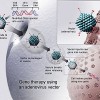Trembling Hands and … Genes?
 Fragile X Tremor/Ataxia Syndrome (FXTAS) is among the most prevalent heritable neurodegenerative disorders. Its symptoms usually develop in men 50 years of age or older and include tremors in arms and hands, balance problems (ataxia), numbness in the extremities, mood instability, short-term memory loss, and gradual intellectual decline. The prevalence of FXTAS is about 2-5 persons per 10,000 in the general population.
Fragile X Tremor/Ataxia Syndrome (FXTAS) is among the most prevalent heritable neurodegenerative disorders. Its symptoms usually develop in men 50 years of age or older and include tremors in arms and hands, balance problems (ataxia), numbness in the extremities, mood instability, short-term memory loss, and gradual intellectual decline. The prevalence of FXTAS is about 2-5 persons per 10,000 in the general population.
The underlying cause for FXTAS is a mutation in the gene for Fragile X Mental Retardation Protein (FMRP), which is located on the X-chromosome; its protein product, Pur-α is essential for normal neural function. Scientists have recently determined the three-dimensional structure for this protein, a first step in the potential identification of an effective treatment that would address the cause and not just the symptoms of FXTAS.
As described in Your Genes, Your Health, the gene contains a region that consists of repeated CGG DNA triplets. In healthy people, both copies of their FMRP gene contain 5-54 copies of the CGG triplet. Disorder manifests itself if the repeat numbers exceed 54 in both gene copies (the disorder is recessive): 55-200 repeats lead to FXTAS, as described above. Repeat numbers exceeding 200 lead to Fragile X Syndrome (FXS), the second most common cause of heritable mental impairment after Down’s syndrome.
Given that the symptoms of FXTAS include shaking hands, it is interesting that the authors describe the shape of the FMRP protein, Pur-α as: “The crystal structure of Pur-α … looks like a hand: four so-called beta-strands, corresponding to four fingers, form a beta-sheet, and an adjacent alpha-helix resembles a thumb.” Apparently, pairs of PUR repeats bind to each other in a configuration that is reminiscent of a handshake, forming a functional unit that binds to RNA.
| Print article | This entry was posted by Uwe Hilgert on October 23, 2009 at 3:01 pm, and is filed under Your Genes, Your Health. Follow any responses to this post through RSS 2.0. You can skip to the end and leave a response. Pinging is currently not allowed. |










